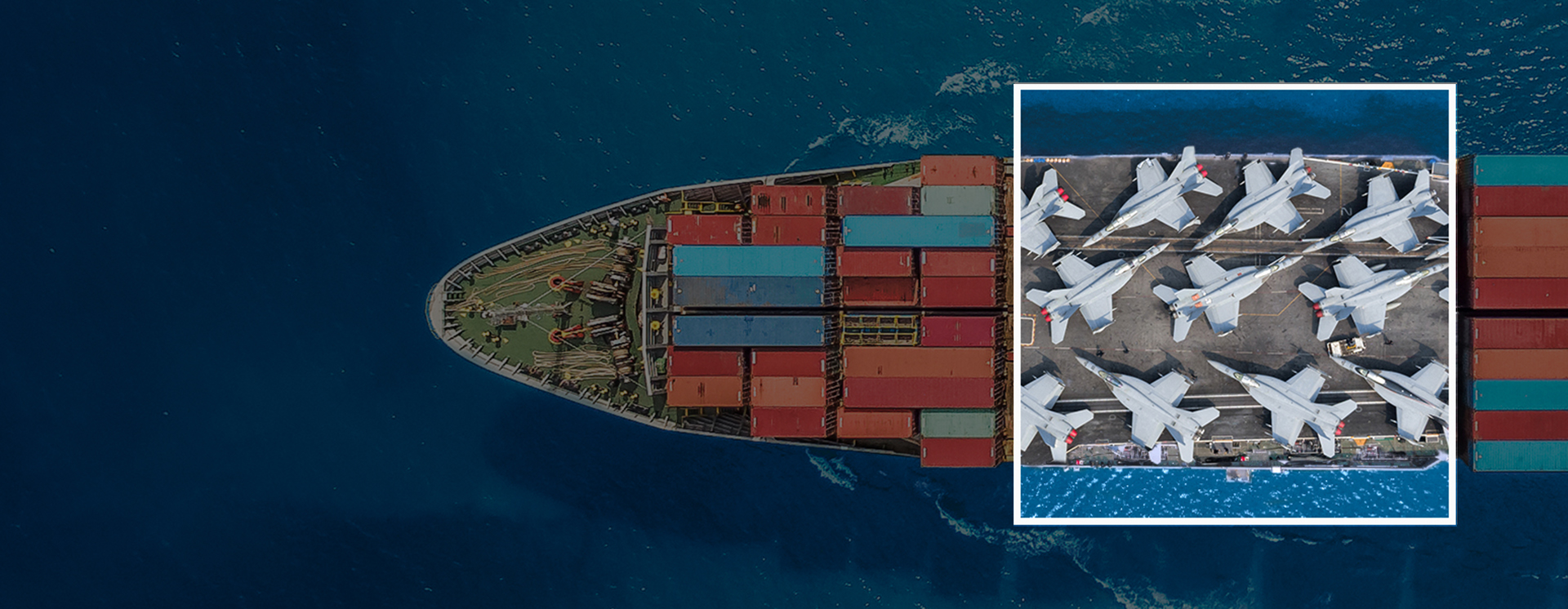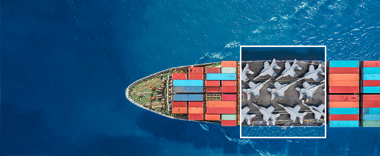Understanding geopolitical conflict and supply chain risks
Geopolitical conflict is one of the greatest threats to the resources needed for a resilient economy, with maritime shipping the biggest target. Shipping alone accounts for more than 80%[14] of the world’s imports and exports – around 11 billion tons of goods[15]. Conflict can easily see major routes blocked, and even alternative routes can be shut down in the event of an escalation of hostilities. Understanding the vulnerability of shipping routes is critical to protecting economies in the event of disruption.
[14] https://unctad.org/publication/review-maritime-transport-2021
[15] https://hbs.unctad.org/world-seaborne-trade/

Regional reliance
One thing is clear, when a crucial supply chain pinch point is blocked, the effects are felt immediately, and ramifications can be long-lasting. When the Ever Given container ship ran aground in March 2021, it blocked the Suez Canal for six days. This single event halted the flow of over 12% of the world’s trade flows through the region.[16] Shockwaves were felt long after the ship had been refloated and continued its journey. Lloyd’s List estimated that Ever Given held up $9.6bn in trade for every day the canal was blocked[17] and caused an estimated 60-day shipping delay[18].
Shipping chokepoints like the Suez Canal, or the Straits around Turkey, Malacca, Hormuz, and Bab el-Mandeb all sit in areas of high geopolitical tension and several trillions of dollars of trade value are at risk as a result. Hormuz, for example is responsible for the transport of more than 30% of the world’s supply of crude oil and 20% of the global LNG supply[19], with confrontation between the US and Iran during 2018-2020 threatening to interrupt this.
Similarly, the Bab el-Mandeb Strait sees an estimated 25% of the world’s shipping pass through, including around 4.5 million barrels of oil daily from the Persian Gulf and Asia.[20] Recognising its strategic importance, several world powers have established significant military presences in the region to guard against potential hostilities.
Malacca, on the other hand, accounts for 70% of China’s petroleum and liquefied natural gas exports[21]. China’s heavy reliance on energy for rapid industrial expansion, makes this route relatively vulnerable to blockage by a competing nation. Likewise, chokepoints like the Suez Canal or the Turkish Straits would be strategically useful points for administrations wishing to gain the upper hand in either political or economic negotiations.
The reliance of modern society on a small number of critical raw materials and energy sources increases the risk that rising geopolitical tensions or conflict could have an immediate and significant impact on world economies. There are export concentrations in consumer goods and electronics, particularly in the microchips that go into anything from computers to cars. There is also limited geographical availability of some raw materials. Lithium can only be found in certain geographies, for example, but it is essential for the global market in battery-powered goods such as mobile phones and computers. The material is also critical to the wholesale shift to electric vehicles, seen by many developed economies as a central pillar of their battle against climate change.
Everyone has some degree of vulnerability to supply chain disruption due to geopolitical conflict. However countries that rely heavily on imports or have the closest economic or political links to countries involved in disputes may be more vulnerable than others. Understanding these dynamics and preparing for potential disruptions is not just prudent - but essential for economic resilience in an increasingly volatile world.
[16] https://www.weforum.org/agenda/2021/03/the-suez-canal-in-numbers/
[17] https://www.bbc.co.uk/news/business-56533250
[18] https://www.wired.co.uk/article/ever-given-global-supply-chain
[19] https://iea.blob.core.windows.net/assets/203eb8eb-2147-4c99-af07-2d3804b8db3f/StraitofHormuzFactsheet.pdf
[20] https://www.nationalgeographic.com/history/article/bab-al-mandan-red-sea-suez-shipping-crisis-houthis-gaza
[21] https://warsawinstitute.org/china-malacca-dilemma/
Glossary
Find useful information provided to help you better understand our scenarios and research methodology.
Explore the impact of geopolitical conflict
The economic impact
The role of insurance
Disclaimer
This report has been produced by Lloyd's Futureset and Cambridge Centre for Risk Studies for general information purposes only.
While care has been taken in gathering the data and preparing the report Lloyd's and Cambridge Centre for Risk Studies do not, severally or jointly, make any representations or warranties on behalf of themselves or others as to its accuracy or completeness and expressly exclude to the maximum extent permitted by law all those that might otherwise be implied.
Lloyd's and Cambridge Centre for Risk Studies accept no responsibility or liability for any loss or damage of any nature occasioned to any person as a result of acting or refraining from acting as a result of, or in reliance on, any statement, fact, figure or expression of opinion or belief contained in this report. This report does not constitute advice of any kind.
Note that this report does not seek to replace or inform any of the mandatory scenarios which Lloyd’s publishes to support the Realistic Disaster Scenario exercises managing agents are required to undertake in respect of the syndicates managed by them.






